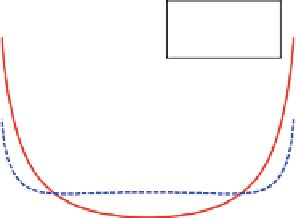Biomedical Engineering Reference
In-Depth Information
0.6
0.5
0.4
0.3
0.2
Coupled model,
γ
=2
The Bell limit
The Griffith limit
0.1
10
-2
10
-1
10
0
10
1
10
2
a
ξρ
0
/E*
Fig. 8.5
The normalized pull-off stress as a function of the normalized adhesion size, also referred
to as the SCI
a
b
0.45
h/a=0
h/a=0.1(1-r
2
)
h/a=0.15(1-r
2
)
h/a=0
h/a=0.1(1-r
2
)
h/a=0.15(1-r
2
)
0.4
0.4
0.35
0.35
0.3
0.3
0.25
0.25
0.2
0.2
0.15
0.15
0.1
-1
-0.5
0
0.5
1
-1
-0.8 -0.6 -0.4 -0.2
0
0.2
0.4
0.6
0.8
1
r
r
Fig. 8.6
The normalized interfacial traction distributions under different values of the contact
shape when the SCI is taken as (
a
)
a ¼
0.1, (
b
)
a ¼
10 and the rebinding rate and the normalized
remote load as
g ¼
2 and
P=ar
0
F
b
¼
0
:
1
shape can be manufactured exactly. The present analysis confirms that these
conclusions are also valid for adhesion via molecular bonds. For example,
Fig.
8.6
shows interfacial stress distribution for different contact surface shapes.
The stress concentration near the adhesion edge decreases as the shape depth
increases, indicating that variations in contact surface shape can significantly
reduce
a
and increase the adhesion strength when the contact size or SCI is large.
On the other hand, when the contact size or
a
is small, the interfacial stress
distribution becomes insensitive to variations in contact surface shape, as shown
in Fig.
8.6b
, where interfacial stress distributions are seen to remain nearly










































































































































































































Search WWH ::

Custom Search